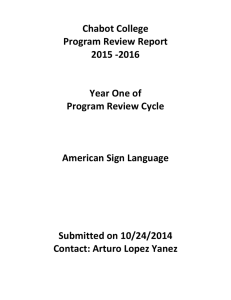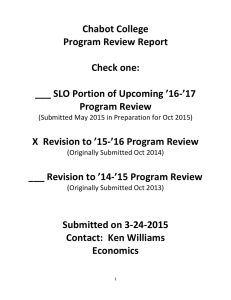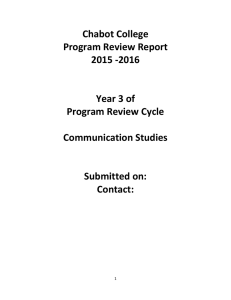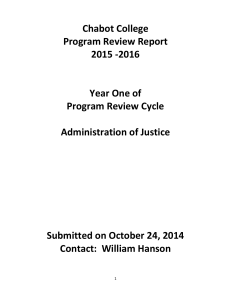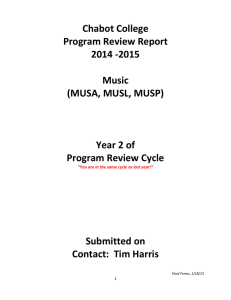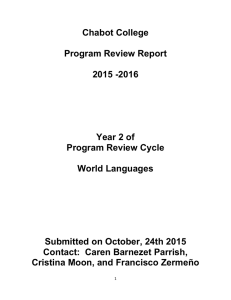Document 11503033
advertisement
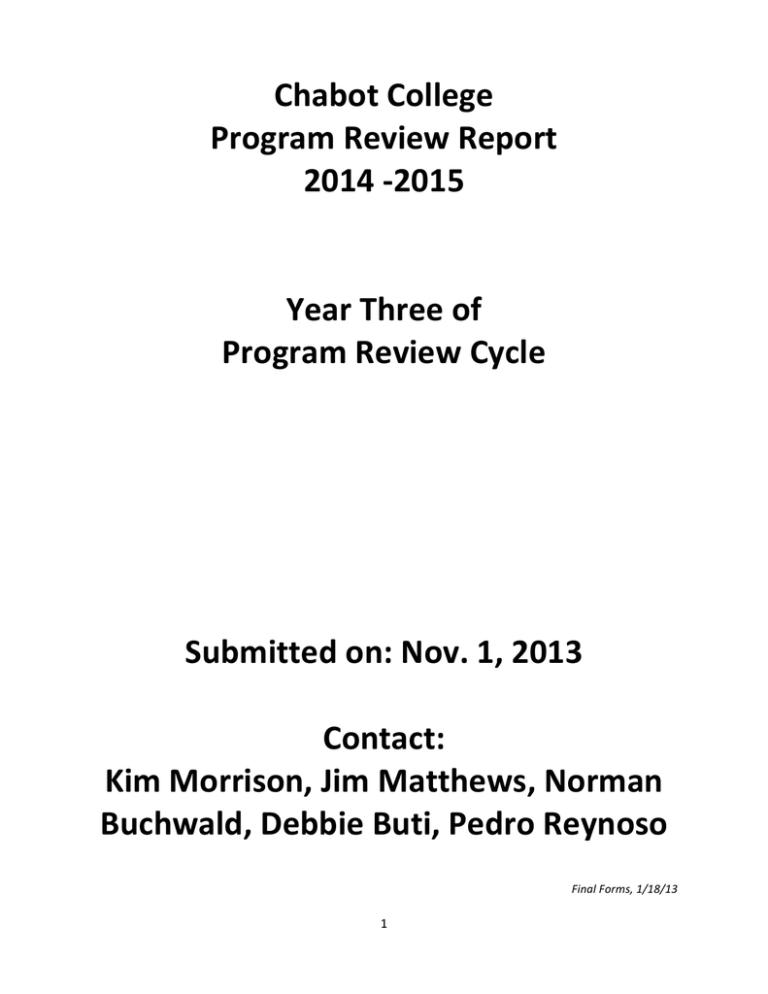
Chabot College Program Review Report 2014 -­‐2015 Year Three of Program Review Cycle Submitted on: Nov. 1, 2013 Contact: Kim Morrison, Jim Matthews, Norman Buchwald, Debbie Buti, Pedro Reynoso 1 Final Forms, 1/18/13 Appendix B2: “Closing the Loop” Course-­‐Level Assessment Reflections. Course LIBS 1 and LIBS 2 Semester assessment data gathered Yes Number of sections offered in the semester 2 Number of sections assessed 2 Percentage of sections assessed 100% Semester held “Closing the Loop” discussion Spring 2012 Faculty members involved in “Closing the Loop” discussion Kim Morrison and Pedro Reynoso Form Instructions: • Part I: CLO Data Reporting. For each CLO, obtain Class Achievement data in aggregate for all sections assessed in eLumen. • Part II: CLO Reflections. Based on student success reported in Part I, reflect on the individual CLO. • Part III: Course Reflection. In reviewing all the CLOs and your findings, reflect on the course as a whole. PART I: COURSE-­‐LEVEL OUTCOMES – DATA RESULTS LIBS 1 CONSIDER THE COURSE-­‐LEVEL OUTCOMES INDIVIDUALLY (THE NUMBER OF CLOS WILL DIFFER BY COURSE« ) (CLO) 1: Develop and implement a search strategy. (CLO) 2: Distinguish between popular and scholarly sources. Defined Target Scores* (CLO Goal) 100% Actual Scores** (eLumen data) 65% 100% 55% LIBS 2 CONSIDER THE COURSE-­‐LEVEL OUTCOMES INDIVIDUALLY (THE NUMBER OF CLOS WILL DIFFER BY COURSE« ) (CLO) 1: Create an annotated bibliography (CLO) 2: Evaluation of information and its sources (CLO) 3: DRAW REFERENCES TO ONES PERSONAL LIFE FROM MATERIALS PRESENTED IN CLASS Defined Target Scores* (CLO Goal) 100% Actual Scores** (eLumen data) 100% 75% 100% 85% « If more CLOs are listed for the course, add another row to the table. 2 75% PART II: COURSE-­‐ LEVEL OUTCOME REFLECTIONS A. COURSE-­‐LEVEL OUTCOME (CLO) 1:LIBS 1 1. How do your current scores match with your above target for student success in this course level outcome? 35% below the 100% target 2. Reflection: Based on the data gathered, and considering your teaching experiences and your discussions with other faculty, what reflections and insights do you have? The importance of presenting this concept as part of a library research continuum or process: 1. Understanding the research assignment 2. Developing a research topic 3. Searching for information 4. Choosing your sources 5. Citing your sources B. COURSE-­‐LEVEL OUTCOME (CLO) 2: 1. How do your current scores match with your above target for student success in this course level outcome? 45% below the 100% target 2. Reflection: Based on the data gathered, and considering your teaching experiences and your discussions with other faculty, what reflections and insights do you have? Although this is a running theme throughout the course supported by handouts outlining the differences between popular and scholarly sources, most students are still at a developing stage in developing an understanding of the nuances of information. 3 COURSE-­‐LEVEL OUTCOME (CLO) 1:LIBS 2 3. How do your current scores match with your above target for student success in this course level outcome? 25% below the target of 100% 4. Reflection: Based on the data gathered, and considering your teaching experiences and your discussions with other faculty, what reflections and insights do you have? Spending more time in creating a practice citation. Also going through the MLA Handout. C. COURSE-­‐LEVEL OUTCOME (CLO) 2: 3. How do your current scores match with your above target for student success in this course level outcome? 25% below the target of 100% 4. Reflection: Based on the data gathered, and considering your teaching experiences and your discussions with other faculty, what reflections and insights do you have? Spend more time on what constitutes plagiarism. What it is? And And its implications? 4 C. COURSE-­‐LEVEL OUTCOME (CLO) 3: 1. How do your current scores match with your above target for student success in this course level outcome? 15% below target of 100% 2. Reflection: Based on the data gathered, and considering your teaching experiences and your discussions with other faculty, what reflections and insights do you have? Laying down grounds rules to make the environment safe for students to talk in class. PART III: COURSE REFLECTIONS AND FUTURE PLANS 1. What changes were made to your course based on the previous assessment cycle, the prior Closing the Loop reflections and other faculty discussions? LIBS 1: Create new assignments that reinforce the differences between popular and scholarly sources, particularly in terms when to use academic sources over popular and vice versa. LIBS 2: Give tangible examples of plagiarism. 2. Based on the current assessment and reflections, what course-­‐level and programmatic strengths have the assessment reflections revealed? What actions has your discipline determined might be taken as a result of your reflections, discussions, and insights? LIBS 1: The importance of this critical information competency in a community college setting; and thus, the continual emphasis in accomplishing this CLO. 5 LIBS 2: When teaching information literacy we are also teaching how information is in our lives i.e. perception, creation, who owns it etc. and the various ways of knowing and various types of knowledge. Various ways of transferring knowledge. 3. What is the nature of the planned actions (please check all that apply)? X Curricular X Pedagogical ! Resource based ! Change to CLO or rubric ! Change to assessment methods ! Other:_________________________________________________________________ 6 Appendix C: Program Learning Outcomes Considering your feedback, findings, and/or information that has arisen from the course level discussions, please reflect on each of your Program Level Outcomes. Program: Library • PLO #1: Formulate and apply research strategies to locate appropriate information to achieve, educational, professional and personal objectives. • PLO #2: Develop a lifelong ethic of learning. The two PLOs above reflect the library’s Core Values. We, the library, believe: • in facilitating access to information by providing multiple access points that support diverse student needs • in teaching students, faculty, classified professionals, and administrators how to find, evaluate, and ethically use information in their respective academic, professional and personal lives • in operating at a high level of professionalism and service • in creating a safe and welcoming environment where all students want to come • in fostering lifetime relationships with libraries PLO Assessment Cycle Assessment Tool Assess Reflect Implement & Adjust Assess Library Student Survey Library Faculty Survey Library Orientation Survey Library Programming Survey Spring 2013 Spring 2013 Spring 2013 Spring 2013 Fall 2013 Fall 2013 Fall 2013 Fall 2013 Spring 2014 Spring 2014 Spring 2014 Spring 2014 Fall 2014 Fall 2014 Fall 2014 Fall 2014 The assessment cycle above shows the different assessment tools used by the library to collect relevant data, which in turn, informs and guides the library’s planning actions. This evidence-­‐ based process helps facilitate the allocation of institutional funding for the sustainability of resources and services at Chabot College Library. The library evaluates resources and services to ensure that identified student needs are met through the appropriate allocation of funds. In short, the library’s outcomes assessment process serves as the basis for improving student success. To this end, the library will conduct its annual Library Student Survey this spring semester (2014). The data collected will then be analyzed and considered for reflection, and ultimately used for the design of new services and resources that meet students’ library and information needs. Case in point, the 2012 Library Student Survey revealed a need for more silent study space at the library. Such valuable student input resulted in the creation of a Silent Study Room, which has been well received by students. 7 Most recently, a Library Faculty Survey was conducted this spring semester (2013). The aim of the survey was two-­‐fold: 1) to gather faculty input on a potential new library building, and 2) to measure the level of satisfaction of library resources and services accessed by Chabot faculty. The data from the survey will be analyzed this semester with the eventual goal of implementing new and/or improved resources and services by spring 2014. Similarly, Library Programming and Library Orientations will follow the same assessment cycle. What questions or investigations arose as a result of these reflections or discussions? Explain: The same reoccurring need continues to dominate the discussion, the need for a Library Instruction Room that is able to accommodate large classes. Our current space (Rm. 119) is limited to 24 computer terminals, a capacity that does not meet the needs of today’s community college courses. Although the use of the WRAC Lab (354), which fits 45 students comfortably, as well as the increase of computers in 119 by using laptops from the Library’s Laptop Lending Program, have served as temporary solutions, the library does not consider them as permanent alternatives to a traditional Library Orientation space; thus the need for the expansion of Rm. 119 or the creation of a 21st century Library Instruction Room as part of a new library building. What program-­‐level strengths have the assessment reflections revealed? Strengths revealed: Data from the 2012 Library Student Surveyconfirmed what librarians have known all along, the value of the library as a meeting space, as a place of collaboration and learning, as a dynamic environment with technology and information at its core; put simply, students need and value a library setting. As discussed earlier, the 2012 Library Student Survey revealed a need for more silent study space at the library. The student input resulted in the creation of a Silent Study Room, which has been well received by students. What actions has your discipline determined might be taken to enhance the learning of students completing your program? Actions planned: Continue to push for a new library building that meets the needs of today’s community college student, while at the same time, supporting program-­‐level strengths in the near future and in years to come. 8
